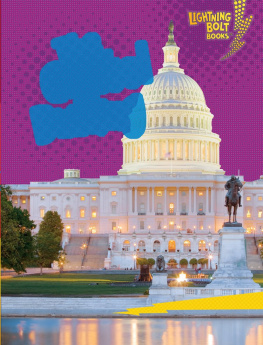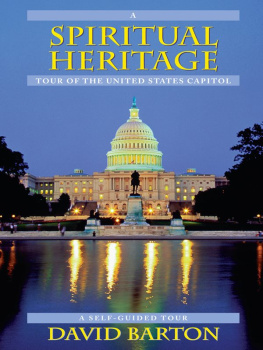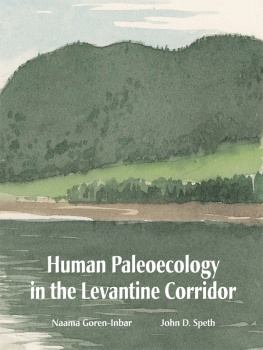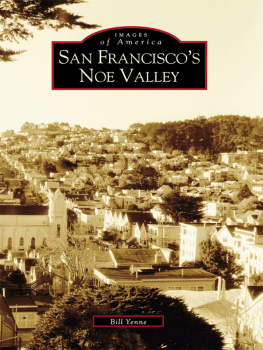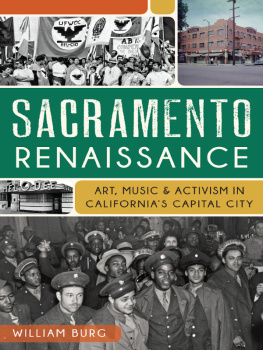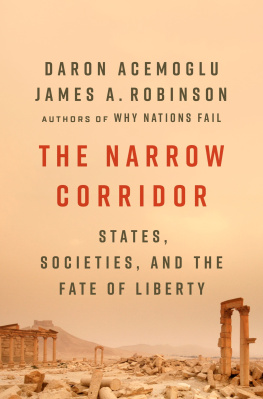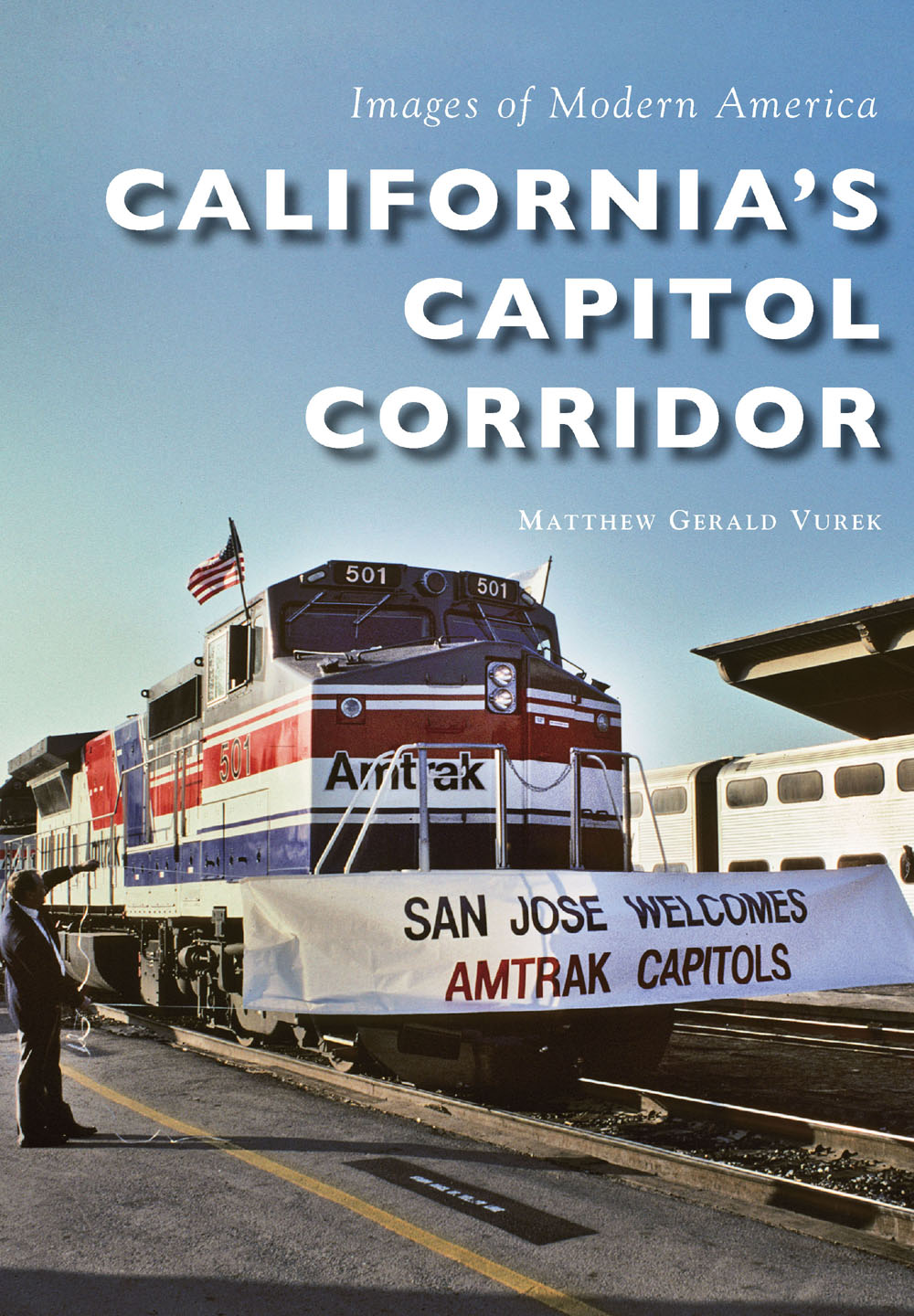
Images of Modern America
CALIFORNIAS
CAPITOL
CORRIDOR

This map shows the 17 Amtrak stations on the 170-mile Capitol Corridor in Northern California. (Courtesy Amtrak.)
FRONT COVER: A special Amtrak train breaking an inauguration banner at the Southern Pacific depot in San Jose, California (Photograph by author; see )
UPPER BACK COVER: ExSanta Fe GE DASH 8-40CW 803 leading a westbound BNSF container train at Hercules (Photograph by author; see )
LOWER BACK COVER (FROM LEFT TO RIGHT): A visiting Swedish Railways ABB X2000 train (Photograph by author; see )
Images of Modern America
CALIFORNIAS
CAPITOL
CORRIDOR
MATTHEW GERALD VUREK

Copyright 2016 by Matthew Gerald Vurek
ISBN 978-1-4671-2417-1
Ebook ISBN 9781439658383
Published by Arcadia Publishing
Charleston, South Carolina
Library of Congress Control Number: 2016940470
For all general information, please contact Arcadia Publishing:
Telephone 843-853-2070
Fax 843-853-0044
E-mail
For customer service and orders:
Toll-Free 1-888-313-2665
Visit us on the Internet at www.arcadiapublishing.com
Dedicated to the people who operate, maintain, manage, regulate, and patronize Californias Capitol Corridor
CONTENTS
ACKNOWLEDGMENTS
The author gratefully acknowledges the assistance of the Honorable Rod Diridon Sr., Bruce Heard, Bruce Shelton, Phil Gosney, David C. Warner, Jon Pullman Porter, Gary Perazzo, Jamie Miller, John Black, and Henry E. Bender Jr. in the preparation of this book. The author also thanks the members of the Central Coast Chapter of the National Railway Historical Society and the Feather River Rail Society for their support and trackside companionship over the past quarter century. Finally, the author thanks his parents, Gerald and Ruth Vurek, and his fiance, Peggy Haynes, for their love and support of his creative endeavors. All photographs were taken on 35-millimeter color transparencies by the author unless otherwise credited.
INTRODUCTION
December 12, 2016, will mark the 25th anniversary of Amtraks passenger service on the Capitol Corridor, the route between Sacramento, the capital of the state of California, and San Jose, the states first capital from its admission to the Union in 1850 until 1851. The corridor extends further east to Auburn in the foothills of the Sierra Nevada. The trackage hosts not only the Amtrak passenger trains but also freight trains of the Union Pacific (and before September 11, 1996, its predecessor Southern Pacific). Small portions of the Capitol Corridor are utilized by BNSF Railway freight trains and the passenger trains of Altamont Corridor Express and Caltrain. Light-rail systems in Sacramento and San Jose connect directly with the Capitol Corridor. In Richmond and Oakland, the San Francisco Bay Area Rapid Transit District trains stop adjacent to the Amtrak stations. The route traverses a veritable buffet of landscapesurban-renewed San Jose, the Don Edwards National Wildlife Refuge, Bay Area suburban backyards, the industrial detritus of Oakland spiced with its redeveloped downtown, the San Pablo Bay shoreline, and the rural enclaves outside Sacramento. During the corridors first 25 years, the railroad changed owners, new equipment appeared, Amtrak passenger service expanded from three round-trips per day to 16, new train stations were built, light-rail service expanded, another commuter train service began, and an assortment of special trains operated over the route. This book documents the Capitol Corridor, from the Silicon Valley to the Sacramento Valley, as it evolved over this time period.
The name Capitol Corridor was birthed from the ballot box on June 5, 1990, when California voters approved Proposition 116, the Clean Air and Transportation Improvement Act. Although a statewide act, its funding language spells out the name Capitol Corridor as the intercity rail service route from Placer County to Santa Clara County that received $85 million in bond money, of which not more than $35 million was allocated for railroad rehabilitation and other improvements to provide intercity rail service between Auburn and Davis.
Prior to the Capitols startup, the only Amtrak passenger service between San Jose and Sacramento was aboard the SeattleLos Angeles Coast Starlight (since April 26, 1982); from October 25, 1981, to September 30, 1983, the state-supported SacramentoLos Angeles Spirit of California also traversed this route. One could also travel between Oakland and Sacramento aboard the Chicago-bound California Zephyr. The last remnant of Southern Pacifics Oakland-Sacramento local passenger service ended on May 31, 1962, when the Senator (trains 223/224) was discontinued. OaklandSan Jose connections for the overnight Lark and Daylight passenger trains were discontinued on May 1, 1960, although those trains did not make any station stops between those two cities.
The route was originally built over 100 years earlier by several predecessors of the 20th-century Southern Pacific Company (many were shell companies with equipment provided by Southern Pacific or partner Central Pacific). These predecessors include:
San Jose & Santa Clara: 1864 by the San Francisco and San Jose Railroad
Newark & Santa Clara: 1877 by the South Pacific Coast Railroad (leased to Southern Pacific in 1887 and subsequently merged)
Newark & Niles (Fremont since 1956): 1909 by the Central California Railway
Niles & Oakland: 1869 by the San Francisco Bay Railroad
Oakland and Martinez: 1878 by the Northern Railway Company. (Note that trains were carried aboard ferryboats from Port Costa to Benicia from 1879 until the Suisun Bay railroad drawbridge was opened between Martinez and Benicia in 1930.)
Benicia & Suisun City: 1879 by the Northern Railway
Suisun City & Sacramento: 1868 by the California Pacific Rail Road
Sacramento & Auburn: 1865 by the Central Pacific
Southern Pacific itself was merged into the Union Pacific Railroad on September 11, 1996, eighty-three years after the US Supreme Court ordered Union Pacific to sell its ownership in Southern Pacific, which it had controlled since 1901.
Union Pacific continues to operate freight service over the Capitol Corridor, and competitor BNSF Railway has trackage rights over portions of it as a condition of the Southern Pacific takeover. Newcomer Altamont Corridor Express (originally named Altamont Commuter Express until 2013) began operation on October 19, 1998, and provides weekday commuter trains from Stockton utilizing the route from Fremont to San Jose.
One
SAN JOSE TO ALVISO
This geographical tour of the Capitol Corridor begins in San Jose, the self-proclaimed Capital of Silicon Valley, which was also Californias state capital from 1850 to 1851. It is the third-largest city in California. Until the industrial contraction of the 1980s, San Jose was a busy junction for the Southern Pacific for its routes between San Francisco, Oakland, and Los Angeles. The railroad once had two large freight-train yards along with a roundhouse to service locomotives. Operations and maintenance of the Peninsula Corridor Joint Powers Board (Caltrain) San FranciscoGilroy commuter trains are based here. It is also the outbound terminal for Altamont Corridor Express (ACE) trains on weekdays. Amtraks Los AngelesSeattle Coast Starlight passenger train also makes a daily stop at the former Southern Pacific depot shared with Caltrain, ACE, and the Amtrak Capitol Corridor trains. Between October 1992 and December 1994, the former Southern Pacific passenger depot, originally opened in 1935, underwent a multimillion-dollar restoration that strengthened the depot for earthquake resistance and restored the building as close as possible to its original appearance. Santa Clara Valley Transportation Authority began service to its light-rail stop here on July 29, 2005.
Next page


